All pilgrims know that there are many routes on the Camino de Santiago to travel, and upon reaching Santiago, they can obtain the Compostela. However, not everyone knows that there are also many other pilgrimage certificates that can be obtained by completing a Jacobean route. If you consider yourself a dedicated pilgrim and want to have an impressive Jacobean resume, keep reading, there is much to explore: the “Pilgrimtheck” of the Camino de Santiago is vast.

Two models of Compostela, the final certificate after completing the Camino de Santiago
Documents issued in Santiago, in addition to the Compostela
Beyond the well-known pilgrim certificate, the Compostela, in Santiago you can obtain other documents, and we will see them below.
The Cotolaya
Also known as the “Franciscan Compostela,” the Cotolaya is a certificate granted by the Franciscan congregation of Santiago to any pilgrim who arrives in the city. It has been issued since 2014, commemorating the 800th anniversary of the pilgrimage of Saint Francis of Assisi to Santiago de Compostela. The name Cotolaya comes from the legend of Saint Francis and the charcoal burner Cotolay. It is known that the Italian monk made the pilgrimage to Santiago in the 13th century, and Cotolay kindly hosted the saint in his home. Moreover, Saint Francis entrusted him with the construction of the current convent of San Francisco, very close to the cathedral. Visit the sacristy of the church of San Francisco and show your duly stamped credential to obtain this free certificate, although donations are accepted.
The “Perregrina”
Our furry canine friends are great companions on the Camino de Santiago, and doing the Camino with your dog is a wonderful experience. Additionally, it turns out that your best friend can be recognized as a “perregrino”, as long as they have their duly stamped canine credential. The Asociación Protectora de Animais do Camiño (APACA) has been issuing the canine credential (3€) and its respective certificate, the “Perregrina” or canine Compostela (free), since 2018.
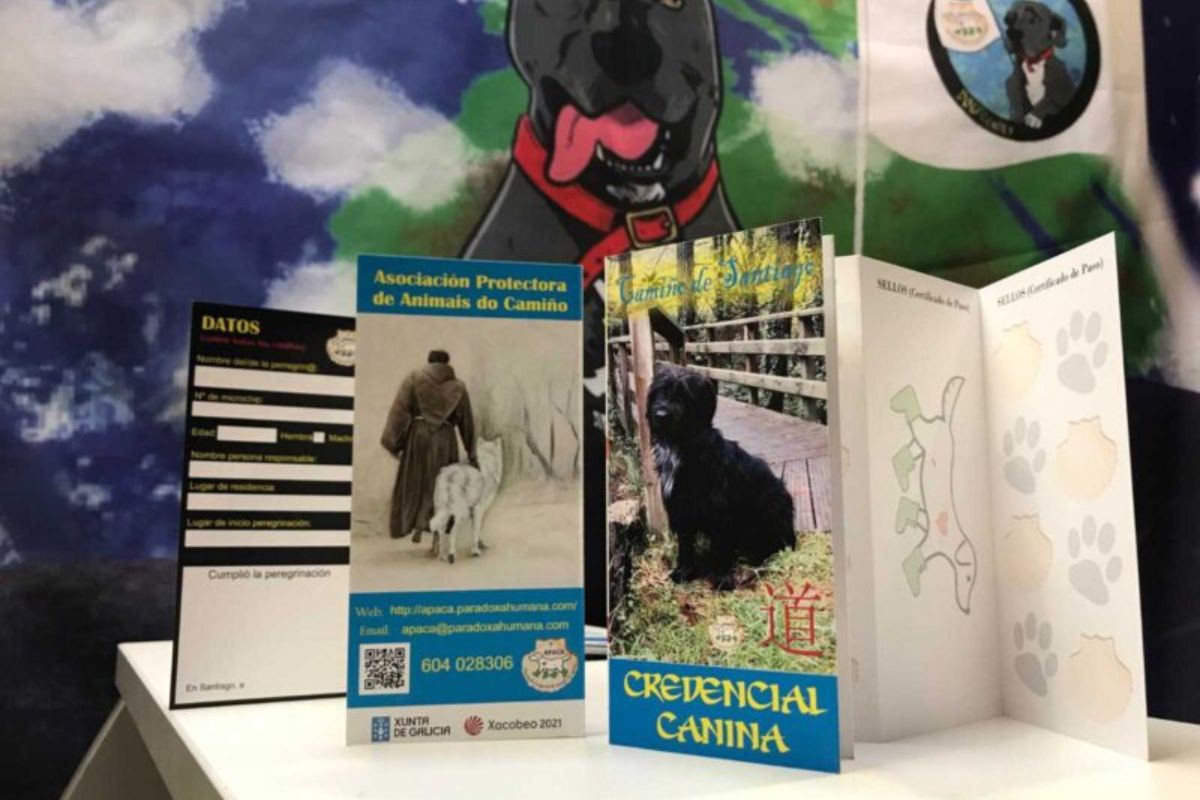
The Canine Credential, with which you can obtain the canine Compostela or “Perregrina”
The Dual Compostela
Since 2015, it has been possible to obtain this special certificate, but we warn you that you will need to travel a bit. This document is issued for free to those who meet the certification requirements by completing the two pilgrimage routes that are World Heritage Sites. Which ones are they? The Camino de Santiago in Spain, of course, and the Kumano Kodo in Japan. It has its own free credential, and you can obtain the certificate once you complete both routes, either in Santiago or in the city of Tanabe (Japan). This is a unique pilgrimage that will take you from one end of the world to the other.
Documents issued along the Camino de Santiago
There are also other certificates that are issued along the Jacobean routes, as proof of arrival at a special place. Some were even formerly certifications of passage that served as safe-conducts for the security and hospitality due to the pilgrim.
The Finisterrana and the Muxiana
Every pilgrim who completes the Camino de Santiago from Finisterre to Muxía can obtain two certificates: the Finisterrana in Finisterre, and the Muxiana in Muxía. This is a very special route that pilgrims take to the End of the World. For both, there is a single credential, which is free and exclusive to this route, and that we must stamp and date. Once we reach these towns, either in their public hostels or in their tourism offices, we can request other free certificates.
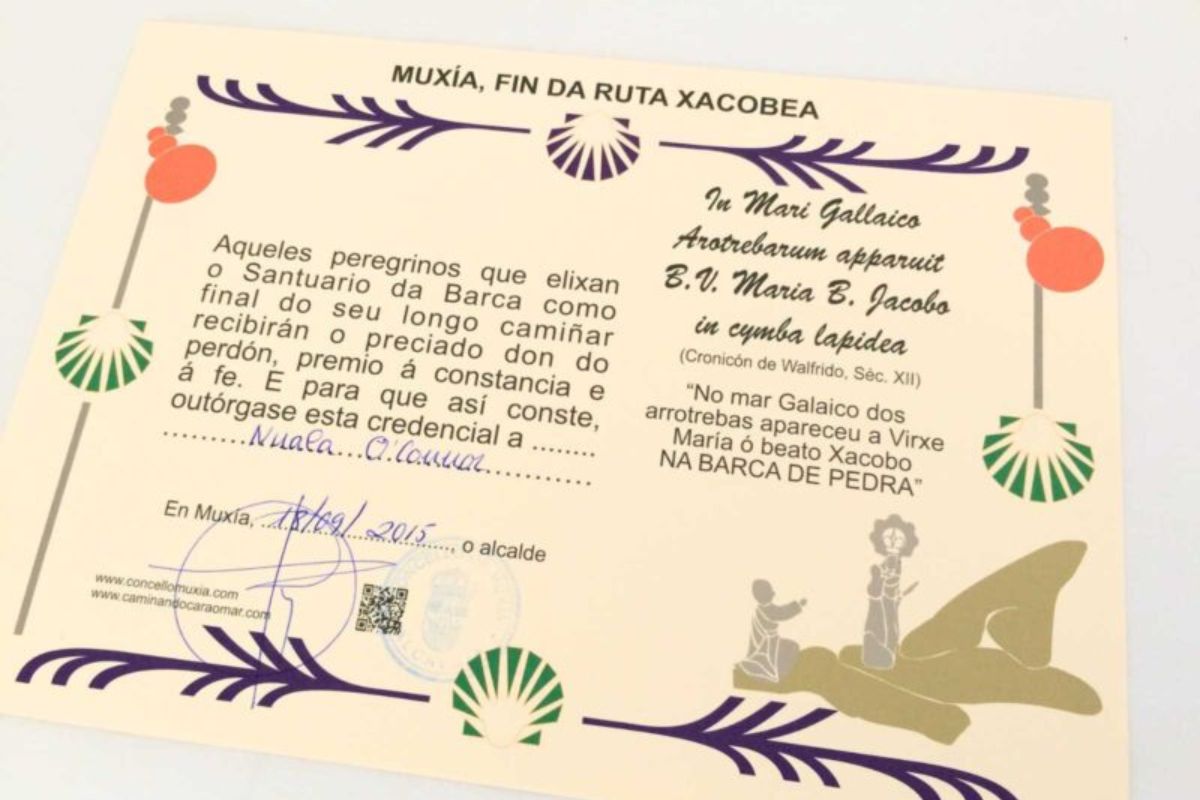
The Muxiana, a document you can obtain upon arriving in Muxía
The Ayeguina
Another ancient safe-conduct is the Ayeguina, a certificate that proves having completed the first 100 kilometers of the French Way from Roncesvalles in Ayegui. It was issued by the medieval monastery of Irache, although today it is issued in the mentioned Navarrese town.
The Olvidada
Upon completing the Camino Olvidado, which runs between Bilbao and Villafranca del Bierzo, the pilgrim can obtain the so-called Olvidada. This certificate, which has its own credential, is issued at the Tourist Office of Villafranca del Bierzo. With another possible start in Pamplona, this Camino de Santiago could be the oldest after the Primitive Way.
The Pedronia
On the Portuguese Way, the pilgrim can obtain a very special certificate. Upon passing through Padrón, where it is believed that the mortal remains of the Apostle Santiago arrived, the pilgrim can request the Pedronia. Likewise, it can be obtained by completing the Portuguese Way along the Coast or the Spiritual Variant. This is a document issued by the Padrón Tourism Office since 2010, and since 2024 it has a cost of €2. It is obtained by presenting the pilgrim’s credential with the stamp of the Church of Santiago in Padrón.
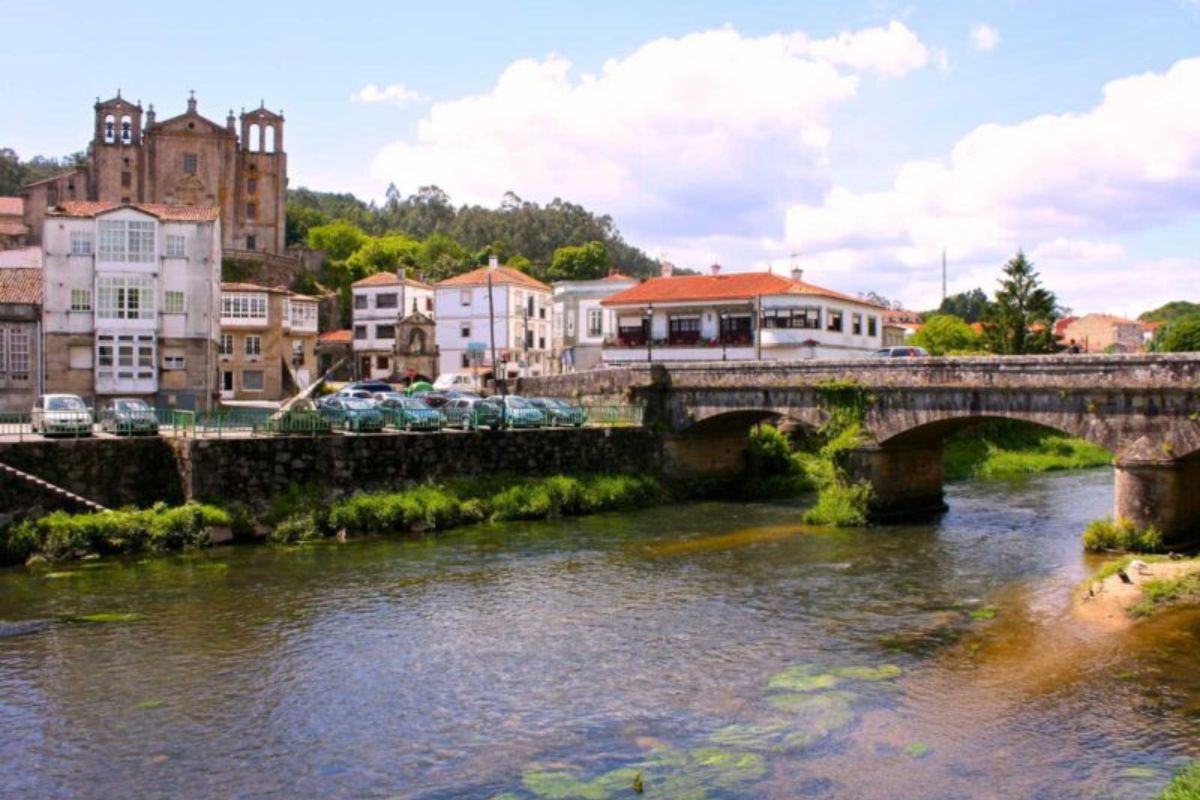
In Padrón, you can obtain the Pedronia
The Lebaniega
This certificate, the Lebaniega, has its own credential, and is issued to any pilgrim who completes the Lebaniego Way. This route is a diversion from the Northern Way in San Vicente de la Barquera to reach the Monastery of Santo Toribio de Liébana. This monastery has guarded the Lignum Crucis for centuries, a relic considered to be part of the wooden cross where Jesus was crucified. Additionally, it celebrates the Lebaniego Jubilee Year, similar to the Holy Jacobean Year in Santiago de Compostela.
The Salvadorana
This certificate is obtained by completing the Camino del Salvador, which runs from León to Oviedo. The saying already confirms the importance of this route: “He who goes to Santiago and not to the Savior, visits the servant and forgets the master”. This saying reminds us that the Holy Chamber of Oviedo houses very important relics such as the Holy Shroud. It is necessary to obtain the credential of the Camino del Salvador in one of the hostels in the province of León. Once in Oviedo, you can get the Salvadorana at the cathedral (4€) and at the pilgrim hostel (2€).
The Ignaciana
This certificate is specific to the Ignatian Way. This is the route that Saint Ignatius of Loyola took in 1522 from Loyola (Guipúzcoa) to Manresa (Barcelona), to embark for the Holy Land. It has its own credential (0.5€), and it can be collected at any institution linked to this route in any of the cities it passes through. It works like the Jacobean credential, although only one stamp and date per stage are required. For its part, the issued certificate (0.5€), the Ignaciana, can be collected at the end of the route, in Manresa, or in Loyola.
The Carta Peregrina
This would be a good example of an ancient safe-conduct that has survived to this day. In the middle of the French Way in the Iberian Peninsula is Sahagún, in the province of León. In the sanctuary of the Virgen Peregrina, or in the Casa de la Cultura of this town, the pilgrim can obtain the Carta Peregrina. It is free, although donations are welcome. Pilgrims who complete the Camino de Santiago from Madrid, which ends in the aforementioned historic city, consider it their final certificate.
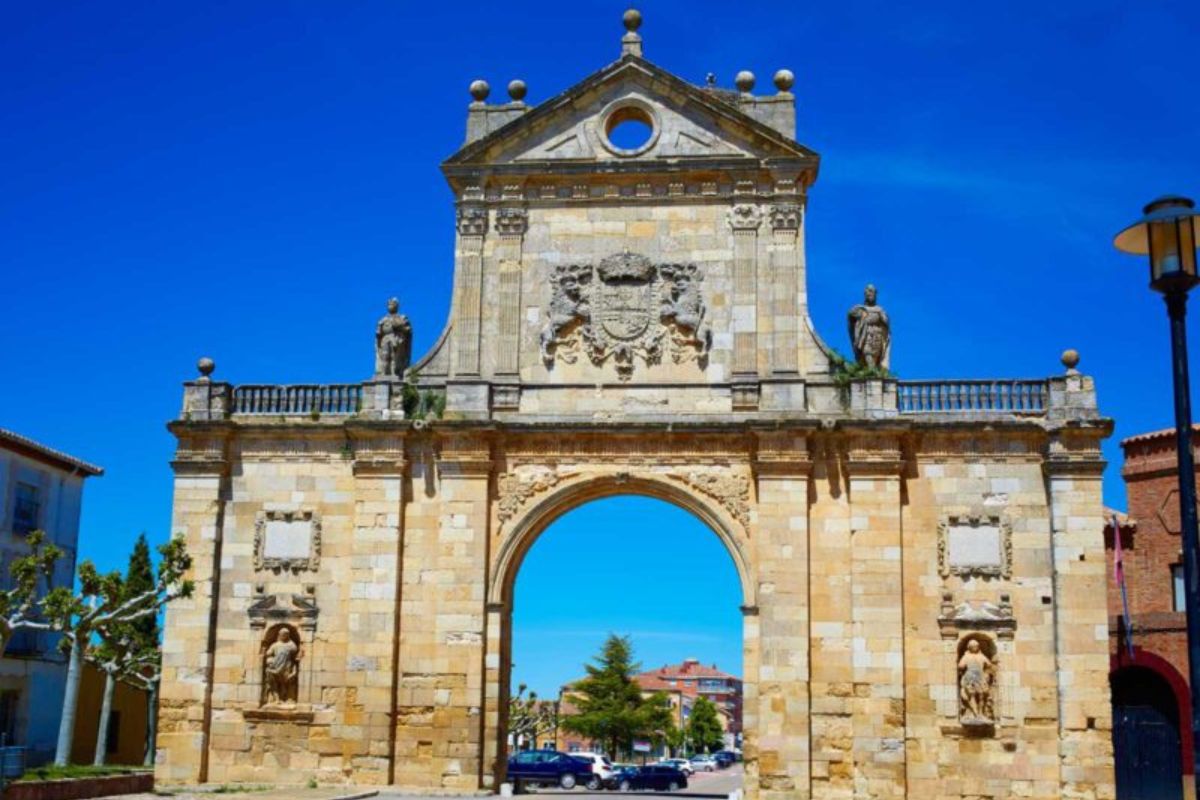
In Sahagún, you can obtain the Carta Peregrina
The Jacobea Canaria
Did you know that there is a Camino de Santiago and a Canary certificate? If you are from the islands, you surely know the Camino de Santiago de Gáldar, the “path between volcanoes” on the island of Gran Canaria. Since 1965, the church of Santiago de los Caballeros in Gáldar has the same privileges as the cathedral of Santiago de Compostela. Therefore, this church and the Jacobean Way, which also has its own credential, offer the possibility of obtaining this Jacobea Canaria.
A vast pilgrim resume
There are many existing routes and certificates. If we missed any, we would love to hear from you in the comments below. If you don’t have one yet, we recommend starting with the first one, the Compostela, and at Viajes Camino de Santiago we can help you obtain it. After your first experience, you will be encouraged to continue walking the different Jacobean routes and expand your pilgrim career. ¡Ultreia!

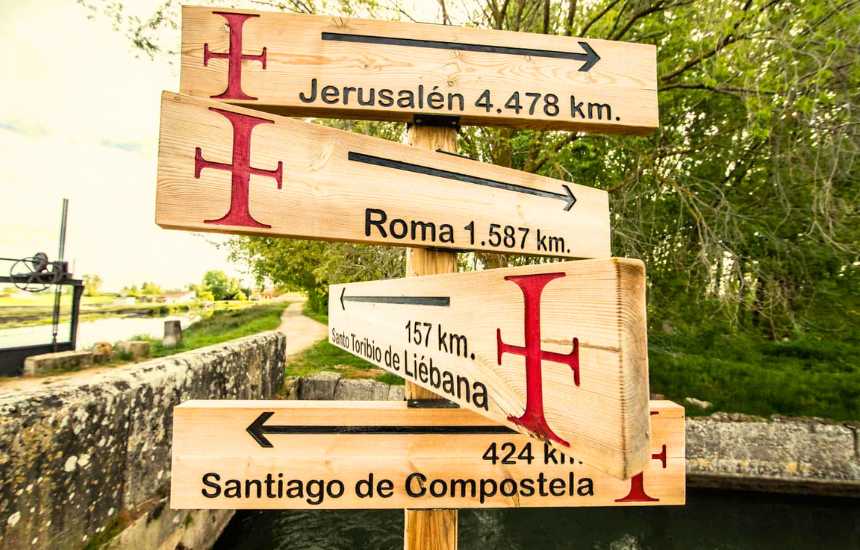










Hola Jorge – Thanks for this information! Can you tell me if there is a way to break up the first stage from Maspalomas? I am more comfortable staying under 20K per day. I have done multiple caminos on different routes with friends & solo – Is this route safe for a solo senior female? Is it possible to arrange to have a bag transported by private taxi each day? Thanks for any help &/or suggestions. Kathi, USA
Hi Kathi,
Thank you for your message and for sharing your Camino experience—it’s wonderful to hear that you’ve already walked several routes!
At the moment, we do not organize the route from Maspalomas, so unfortunately we can’t assist directly with that itinerary. However, you can find more information about the route and possible options here:
👉 Way of Saint James in Gran Canaria – Gáldar
As for your questions:
– It is possible to split some of the stages, but the terrain and infrastructure are more limited compared to mainland Camino routes.
– Safety: Many solo walkers do this route, including senior women, but keep in mind that some sections are remote, and services are sparse, so good planning is essential.
– For luggage transport, you may be able to arrange it locally through private taxi services, but this must typically be coordinated in advance, especially given the limited options along the way.
I hope this helps as a starting point, and if you ever decide to walk a mainland Camino again, we’d be thrilled to help you organize it.
Warm regards and Buen Camino!
Many Thanks Jorge ! I’ll give them a try.
Hi Bill! Many thanks to you! Pleased to share knowledge about the Camino! Kind regards, and Ultreia!
Thanks so much for replying. No not the “Caravacensis” there it is certificate that has been issued at some time called the “Cartagena” I can find no other reference than the enclosed link. Maybe some kind of jubilee certificate ??
https://www.gronze.com/articulos/otras-compostelas-70-diplomas-peregrinaciones-repartidas-por-mundo-32584
Best regards,
Bill
Thank you for your new comment, Bill. I couldn’t find much information about the “Cartagena” certificate either, but it might be related to a special recognition or jubilee certificate issued in the past. You might be able to learn more by reaching out to the Asociación de Amigos del Camino de Santiago de Cartagena. Here are their details (saw here):
Address:
C/ Alfonso X «El Sabio», nº 37-39, bajo (30204)
Cartagena (Murcia)
Phone:
+34 968 316 845
Website:
Although their provided links seem to no longer work, here are the references:
I hope this helps in your search! Let me know if you find out more.
Hey Jorge, do you know if they still issue the “Cartagena” ??
Hi Bill, I’m not familiar with the “Cartagena.” Perhaps you’re referring to the Pilgrim Certificate (Caravacensis) related to the Cross of Caravaca in Murcia. You can find more information here: [Caravaca Pilgrim Credential](https://www.turismoregiondemurcia.es/camino_eng/pilgrims_card/). We’ll make sure to include it in the article. Thanks for bringing it up!